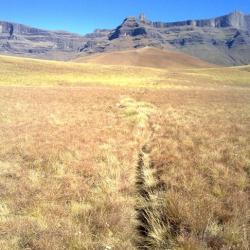Peaks
Peaks
Mont-aux-Sources, two French missionaries, and the ascent that never happened
- Details
- Written by Thomas Wimber
- Parent Category: Drakensberg
- Category: Peaks
- Hits: 13080
In climbing parlance the rewards of the summit assault and final steps ‘into thin air’ are mentally satisfying and hopefully visually pleasing, moreover if the climb is a first ascent and establishes itself in august written testimony. Consider this pioneering triumph after a long slog through unknown territory:
Strange echoes were heard in April 1836 as two devout French missionaries . . . . T. Arbousset and F. Daumas stood at the edge of the [Drakensberg] Escarpment and looked down in utter amazement as they watched the waters of the Tugela crashing down to the gorge below. Realizing the geographic importance of the mountain, they named it Mont-aux-Sources. (Dodds, 1975, p 20)
The 10 highest South African summits not shared with Lesotho
- Details
- Written by Thomas Wimber
- Parent Category: Drakensberg
- Category: Peaks
- Hits: 3310
The following list reflects the highest summits in South Africa which are not shared with Lesotho. It will be recalled that many of South Africa's highest summits form part of the border between the two countries.
“Mafadi”: the invention of a peak and the misconstructions of RSA mapmakers
- Details
- Written by Thomas Wimber
- Parent Category: Drakensberg
- Category: Peaks
- Hits: 12400
Devil's Tooth collapses
- Details
- Written by Vertical Endeavour
- Parent Category: Drakensberg
- Category: Peaks
- Hits: 5886
The iconic Devils Tooth, a well-know peak at the Amphitheatre, has finally collapsed. Reports from hikers on Tuesday afternoon, 29 March, could only be verified on Wednesday due to the mist. Details are not entirely clear at this point how and when it happened exactly, but it is believed that a massive landslide on the southern slopes of the peak weakened it's base, causing it to topple over and fall down the slopes leading to the Busingata Valley below. The landslide was triggered by recent heavy rainfall in the region.
This legendary peak will truly be missed in the Drakensberg.
EDIT: Please note that this is an April Fool's joke!
Should Sterkhorn be renamed Mount Mandela?
- Details
- Written by Chris Sommer
- Parent Category: Drakensberg
- Category: Peaks
- Hits: 6463
A call has been made to rename Sterkhorn, in the Monk's Cowl area, Central Drakensberg, to "Mount Mandela" in honour of Nelson Mandela. This proposal was put forward in a recent speech by John Tungay, founder of the Drakensberg Boys Choir School.
The Khulus above 3300m - details
- Details
- Written by Chris Sommer
- Parent Category: Drakensberg
- Category: Peaks
- Hits: 3457
The Khulus are the peaks in South Africa above 3000m, all of which are found in the Drakensberg. This article focuses on the Khulus above 3300m, which are South Africa's top peaks. The Khulus may be roughly classified according to form and location. This additional information is tabulated below for the top Khulus in addition to the co-ordinates for each peak. Thumbnails of the peaks are also shown which link to the dedicated gallery.
The Khulus above 3300m
- Details
- Written by Chris Sommer
- Parent Category: Drakensberg
- Category: Peaks
- Hits: 12503
There are 25 summits above 3300m in South Africa, several of which are unnamed, and many of which are hardly known. They belong to a greater group of peaks known as the Khulus - the 3000m peaks, found in the Drakensberg.
Defining the Khulus
- Details
- Written by Chris Sommer
- Parent Category: Drakensberg
- Category: Peaks
- Hits: 7193
In Scotland the mountains above 3000ft (914m) are referred to as the Munros. This concept is well understood and people take on the challenge of climbing all of the 284 Munros that are currently listed. A similar concept in the South Africa are the Khulus, the peaks above 3000m, of which there are more than 160. All of them are in the Drakensberg range. The name is the Zulu word for “big” - an apt description of these peaks. The first list was compiled by Cliff Murch, published in the Mountain Club of South Africa Journal 1994. Unfortunately Murch committed suicide in 1996 and never continued his pursuit and research of the Khulus. We value his contribution and take on his challenge to know and climb them.


